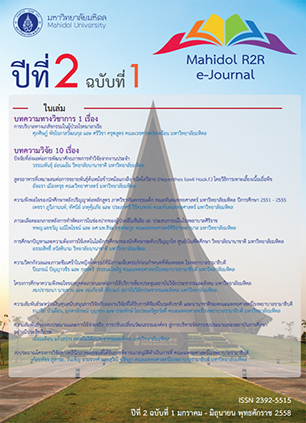สูตรอาหารที่เหมาะสมต่อการขยายพันธุ์ต้นหม้อข้าวหม้อแกงลิง ชนิดโลวิอาย(Nepenthes lowii Hook.f.) โดยวิธีการเพาะเลี้ยงเนื้อเยื่อพืช
DOI:
https://doi.org/10.14456/jmu.2015.3คำสำคัญ:
หม้อข้าวหม้อแกงลิง, Nepenthes lowii Hook.f, การเพาะเลี้ยงเนื้อเยื่อ, N6-benzylaminopurine (BAP)บทคัดย่อ
หม้อข้าวหม้อแกงลิงชนิดโลวิอาย (Nepenthes lowii Hook.f.) เป็นพืชเฉพาะถิ่นของเกาะบอร์เนียว เนื่องจากหม้อข้าวหม้อแกงลิงชนิดนี้ผลิตหม้อที่มีลักษณะสวยงามแปลกตา ทำให้มีการนำหม้อข้าวหม้อแกงลิงชนิดนี้ออกมาจากธรรมชาติเพื่อผลทางการค้าจำนวนมาก ส่งผลให้หม้อข้าวหม้อแกงลิงชนิดนี้ในธรรมชาติมีจำนวนลดลง ซึ่งสหภาพสากลว่าด้วยการอนุรักษ์ (International Union for Conservation of Nature, IUCN) ได้ขึ้นบัญชีแดง (IUCN Red List of Threatened Species) ให้หม้อข้าวหม้อแกงลิงชนิดนี้อยู่ในสถานภาพของสิ่งมีชีวิตที่เกือบอยู่ในข่ายใกล้การสูญพันธุ์ ดังนั้นจึงจำเป็นอย่างยิ่งที่จะต้องขยายพันธุ์หม้อข้าวหม้อแกงลิงชนิดโลวิอายให้ได้จำนวนมากเพื่อการอนุรักษ์ ทั้งนี้วิธีการเพาะเลี้ยงเนื้อเยื่อเป็นวิธีการที่เหมาะสมต่อการขยายพันธุ์ให้ได้ปริมาณมากในระยะเวลาสั้น การศึกษานี้จึงทดลองสูตรอาหารที่เหมาะสมต่อการขยายพันธุ์หม้อข้าวหม้อแกงลิงชนิดโลวิอายในหลอดทดลอง โดยนำยอดอ่อนปลอดเชื้อขนาด 1 เซนติเมตร มาเพาะเลี้ยงบนอาหารวุ้นสูตร Murashige and Skoog (MS) ที่มี N6-benzylaminopurine (BAP) เข้มข้น 0 - 5 มก./ล. พบว่าอาหารวุ้นสูตร MS ที่มี BAP เข้มข้น 2 มก./ล. สามารถชักนำให้ต้นอ่อนหม้อข้าวหม้อแกงลิงชนิดโลวิอายเกิดยอดใหม่มากที่สุดเฉลี่ย 34 ยอด/ชิ้นพืช ภายใน 32 สัปดาห์
เอกสารอ้างอิง
2. Nongrum I, Kumaria S, and Tandon P. Multiplication through in vitro seed germination and pitcher development in Nepenthes khasiana Hook. f., a unique insectivorous plant of India. Journal of Horticultural Science and Biotechnology. 2009;84(3):329-332.
3. Jala A. Effects of Different Light Treatments on the Germination of Nepenthes mirabilis. International Transaction Journal ofEngineering, Management, & Applied Sciences & Technologies. 2011;2(1):83-91.
4. George EF, Hall MA and De Klerk GJ. Plant propagation by tissue culture, 3rd edition. Netherlands: Springer; 2008.
5. Murashige T. and Skoog F. A revised mediumfor rapid growth and bio assays with tobacco tissue cultures. Physiologia plantarum. 1962;15(3):473-497.
6. พีรเดช ทองอำไพ. สารควบคุมการเจริญเติบโตของพืชพืชและสารสังเคราะห์ แนวทางการใช้ประโยชน์ในประเทศไทย. กรุงเทพมหานคร: หจก. ไดนามิคการพิมพ์; 2529.
7. อรดี สหวัชรินทร์. หลักการเพาะเลี้ยงเนื้อเยื่อพืช. กรุงเทพมหานคร: ภาควิชาพืชสวนคณะเกษตร มหาวิทยาลัยเกษตรศาสตร์; 2539.
8. Chua LSL and Henshaw G. In vitro propagation of Nepenthes macfarlanei. Journal of Tropical Forest Science. 1999;11:631-638.
9. Latha PG and Seeni S. Multiplication of the endangered Indian pitcher plant (Nepenthes khasiana) through enhanced axillary branching in vitro. Plant cell, tissue and organ culture. 1994;38(1):69-71.
10. ปิยะดา ธีระกุลพิศุทธิ์. สรีรวิทยาและเทคโนโลยีชีวภาพของพืชเบื้องต้น. ขอนแก่น: ภาควิชาชีววิทยา คณะวิทยาศาสตร์ มหาวิทยาลัยขอนแก่น; 2545.
11. Loc NH, Duc DT, Kwon TH. And Yang MS. Micropropagation of zedoary (Curcuma zedoaria Roscoe)–a valuable medicinal plant. Plant cell, tissue and organ culture. 2005;81(1):119-122.
12. รัตนาภรณ์ จองไพรจิตรสกุล. ผลของไซโทโคนินต่อการเพิ่มปริมาณต้นอ่อนเอื้องผึ้งในสภาพปลอดเชื้อ. Rajabhat Journal of Science, Humanities & Social Sciences. 2013;14(1):25-31.
13. Kadota M. and Niimi Y. Effects of cytokinin types and their concentrations on shoot proliferation and hyperhydricity in in vitro pear cultivar shoots. Plant Cell, Tissue and Organ Culture. 2003;72(3):261-265.
ดาวน์โหลด
เผยแพร่แล้ว
ฉบับ
ประเภทบทความ
สัญญาอนุญาต




